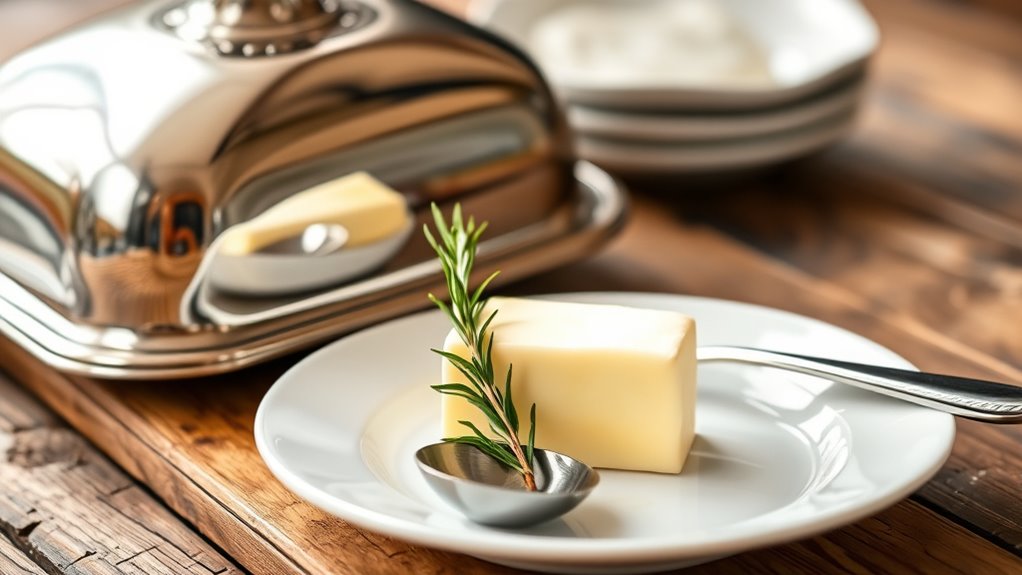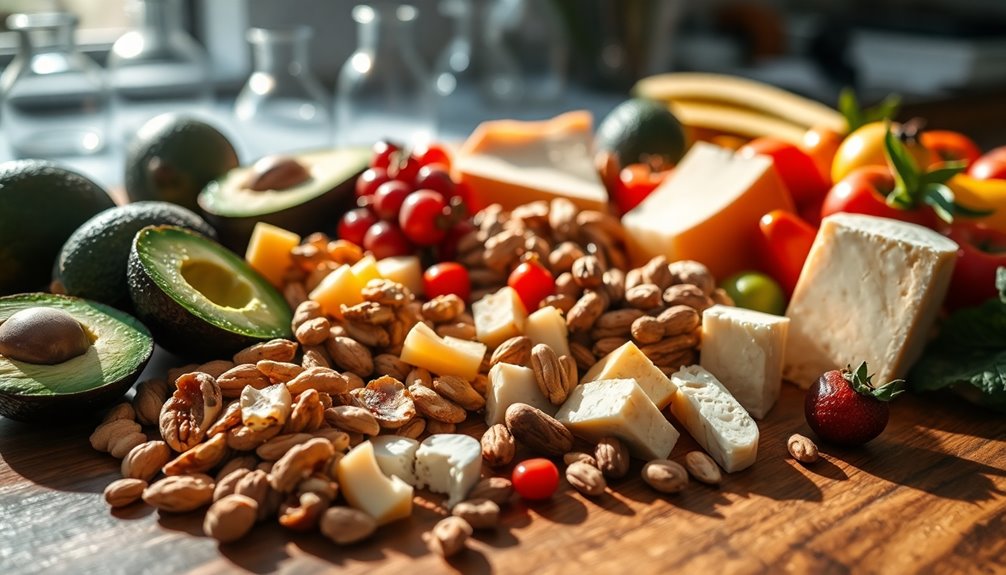A typical serving of butter is about one tablespoon. This portion gives you around 100 calories and 11 grams of fat, which is why portion control really matters. It helps you enjoy butter’s rich flavor without overdoing it on calories or saturated fat. Keeping an eye on your serving size can help maintain your health goals. Want to learn how to incorporate butter into a balanced diet while being mindful? There’s more to discover!
Key Takeaways
- A typical serving size of butter is about 1 tablespoon.
- Each tablespoon of butter provides approximately 100 calories and 11 grams of fat.
- Moderation is crucial to avoid excessive saturated fat intake for health.
- Use measuring tools to ensure proper serving sizes for portion control.
- Consider butter alternatives like olive oil or Greek yogurt for varied flavor and nutrition.

Have you ever wondered how much butter you should really be using? It’s a common question, especially when you’re trying to balance taste and health. Butter is often seen as a delicious addition to many dishes, but knowing the right amount can make a difference in both flavor and nutrition. A typical serving size of butter is about one tablespoon, which offers around 100 calories and 11 grams of fat. While it brings a rich flavor to your meals, it’s essential to be mindful of how much you’re using, especially if you’re watching your calorie intake.
When you think about butter nutrition, it’s clear that moderation is key. Butter contains saturated fat, which, when consumed in excess, can lead to health issues. However, it also provides vitamins A, E, and K, along with beneficial fatty acids. So, how do you enjoy butter without overdoing it? Portion control is vital. By sticking to one tablespoon per serving, you can enjoy the taste without compromising your health goals.
If you find yourself running low on butter or simply want to cut back, there are several butter substitutions you can try. For baking, unsweetened applesauce or Greek yogurt can work wonders. They provide moisture and a hint of sweetness without the added fat. If you’re sautéing vegetables, olive oil or avocado oil can be excellent alternatives that add healthy fats to your diet. You might also consider using nut butters, which can provide a unique flavor and a different nutritional profile.
Experimenting with these substitutions can reveal new flavors in your cooking while helping you maintain a healthy balance. Just remember, it’s not about completely eliminating butter but rather finding the right amount that fits your lifestyle. Additionally, being aware of your overall diet, including on-device AI capabilities, can help you make better choices when it comes to portion sizes.
Incorporating butter mindfully into your meals can enhance your dishes without overwhelming your nutrition goals. Enjoying a pat of butter on your toast or in your recipes can still be part of a balanced diet. Just be sure to measure out your serving size and consider those tasty alternatives when you want to mix things up. Ultimately, it’s all about finding what works for you, enjoying your food, and keeping your health in check. So, the next time you’re reaching for that butter, think about the portion you’re using and how you can make the most of it.
Frequently Asked Questions
Can I Substitute Butter With Margarine for Serving Size?
Yes, you can substitute butter with margarine, and many people do so for various reasons. Margarine vs butter often comes down to dietary preferences and health considerations. Margarine typically contains less saturated fat and may have added vitamins, which can be a benefit. Just keep in mind that the flavor and texture may differ slightly. When using margarine, you can enjoy similar results in your recipes while potentially reducing cholesterol intake.
Does Cooking Method Affect Butter Serving Size Recommendations?
Yes, cooking methods definitely affect butter serving size recommendations. For instance, sautéing uses less butter than baking, where butter absorption is higher. When you fry, you might need more butter for flavor, while roasting can require less due to the even heat. With techniques like grilling, you’ll find that a smaller amount suffices. So, as you choose your cooking technique, consider how much butter you’ll actually need to achieve the desired taste.
How Do I Measure Butter Accurately Without a Scale?
To measure butter accurately without a scale, you can use butter measurement tools like tablespoons or a measuring cup. One stick of butter typically equals half a cup, which you can mark on the wrapper for easy reference. For visual portion estimation, remember that one tablespoon is about the size of your thumb. This way, you can get the right amount of butter for your recipes without needing a scale.
Is There a Difference in Serving Size for Salted vs. Unsalted Butter?
When it comes to butter, think of salted and unsalted as two dancers in a flavorful duet. The serving size remains the same, but the flavor differences can sway your dish dramatically. Salted butter packs a savory punch that enhances recipes, while unsalted offers a pure creaminess, letting other ingredients shine. Depending on your cooking needs, choose wisely, as each type can transform your meal from ordinary to extraordinary!
Can Butter Be Part of a Healthy Diet in Larger Portions?
Yes, butter can be part of a healthy diet in larger portions, but moderation’s key. When you enjoy butter health benefits, like vitamins A, D, and K, balance it with other nutrient-rich foods. Don’t overdo it, though; too much saturated fat can lead to health issues. Focus on quality and choose grass-fed options when possible. Ultimately, it’s all about how you incorporate it into your meals without sacrificing overall nutrition.
Conclusion
So, next time you’re about to slather a stick of butter on your toast, remember: a serving is just a tablespoon! But hey, who needs moderation when you can have flavor? Just think of it as a “healthy” fat—like avocado, but with a side of regret. Go on, indulge! Your arteries will appreciate the drama. After all, why settle for a little butter when you can drown your bread in a buttery masterpiece? Enjoy the spread!










